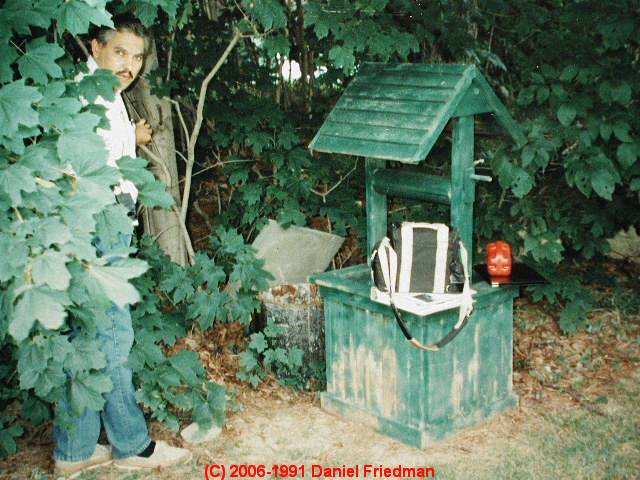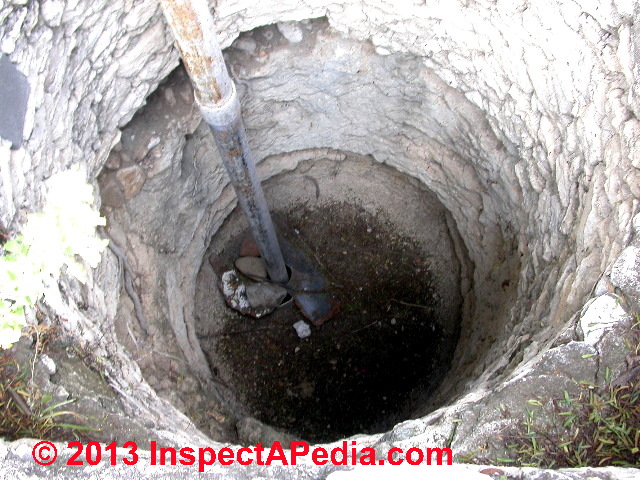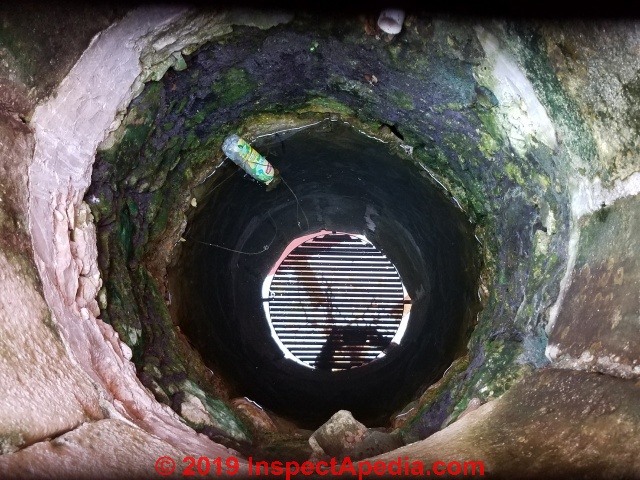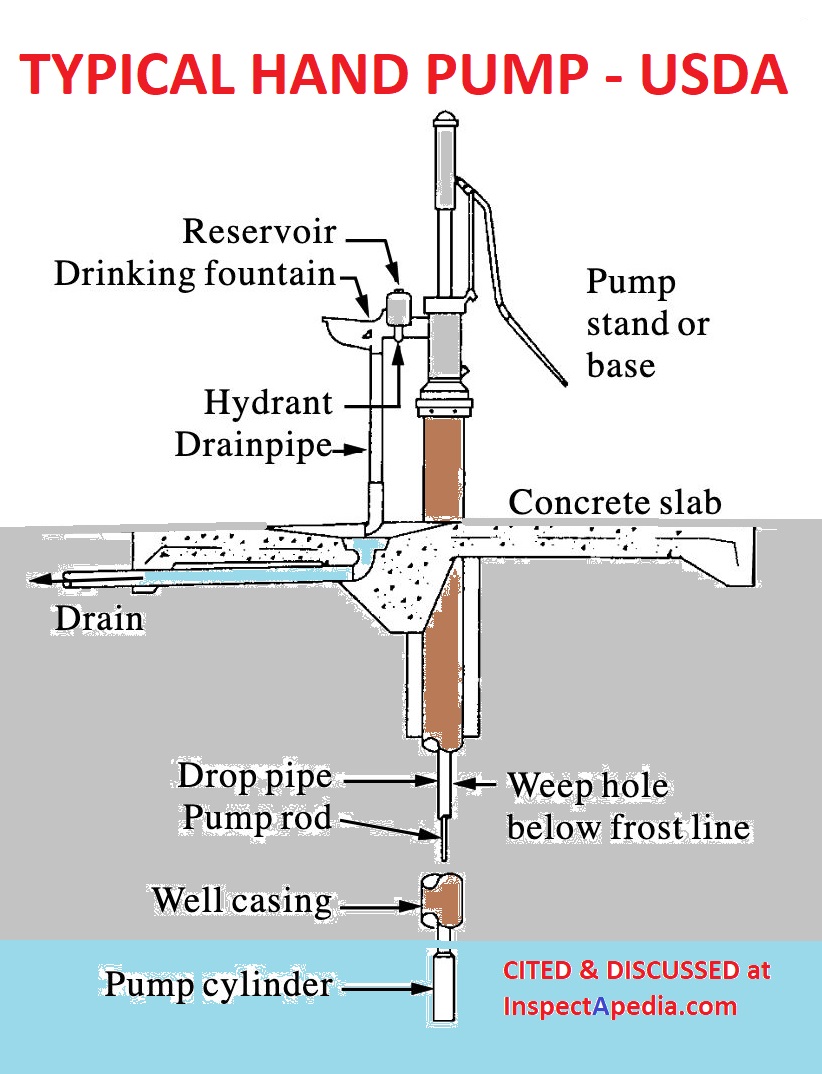 Hand Dug Water Well Sanitation
Hand Dug Water Well Sanitation
Assure safe drinking water from hand excavated water wells
- POST a QUESTION or COMMENT about hand dug water wells, construction, inspection, safety, sanitation, and well collapses
Hand dug well contaminants & dug well water potability or safet.
We discuss how a hand dug well is constructed, maintained, and kept sanitary or "safe to drink".
This article series offers advice for hand dug water wells and the sanitation and maintenance concerns with this water supply type.
InspectAPedia tolerates no conflicts of interest. We have no relationship with advertisers, products, or services discussed at this website.
- Daniel Friedman, Publisher/Editor/Author - See WHO ARE WE?
Sanitation Advice for Hand Dug Wells - Dug Well Contamination
 The chemistry of water in a dug well, and its sanitation, depend on how much surface runoff is entering the well and other factors such as the well's depth.
The chemistry of water in a dug well, and its sanitation, depend on how much surface runoff is entering the well and other factors such as the well's depth.
Watch out: Shocking a hand dug well to "fix" a bacteria problem in its drinking water is probably pointless.
It is almost impossible to keep a dug well sanitary - the Dug well is completely open to both surface runoff and ground water runoff.
You can shock the dug well, but if you can not drill a modern sanitary well in order to assure safe potable drinking water you will probably need to install water treatment equipment to sanitize the water - after testing to see what contaminants besides bacteria are present.
The US EPA has listed the most-common contaminants found in shallow or hand-dug wells:
- Microbiological contaminants: eColi, coliform, or other bacteria, viruses, and parasites common in surface runoff and in shallow groundwater,
risking gastrointestinal illness & serious infections.
Also see BACTERIA LEVELS in WATER, INTERPRETATION for water test results. - Nitrates & nitrites: common especially where farming is nearby or where fertilizers have been used - risking methemoglobinemia or "blue baby syndrome". .
Infants below six months who drink water with high levels of nitrate can become seriously ill and die. - Heavy metals such as arsenic, antimony, cadmium, chromium, copper, lead, selenium & others, risking acute and chronic toxicity, liver, kidney, and intestinal damage, anemia, and cancer.
- Organic chemicals - in inks, dyes, pesticides, paints, pharmaceuticals, solvents, petroleum products, sealants, and disinfectants.
Organic chemicals can enter ground water and contaminate private wells through waste disposal, spills, and surface water run-off - risking damage to their kidneys, liver, circulatory system, nervous system, and reproductive system. - Radionuclides - radioactive forms of elements such as uranium and radium.
Radionuclides ... contaminate private wells through groundwater flow, waste water seepage and flooding - causing toxic kidney effects and increased risk of cancer. - Fluorides - excessive consumption of fluoride can cause skeletal fluorosis, a condition characterized by pain and tenderness of bones and joints
- (US EPA 2020)
More about this problem is
Our photo illustrates a hand dug well that was later converted to a drilled well with a steel casing. The old well pit is functioning now as a well pit.
[Click to enlarge any image]
We noticed that there down in the "pit" formed by the original dug well there is still no protection against surface runoff entering the top of the well casing - a sanitary or water potability concern.
This rural well is being used for crop watering in San Miguel de Allende.
A dug well that gave sanitary drinking water a hundred years ago may be at greater risk of contamination today as more chemicals contaminate both surface runoff and groundwater. And it's hard to keep contaminants out of a dug well.
OPINION: While 100 years ago or more surface water found in dug wells and springs was often of high quality and potable - at least in some areas of the world.
But today it is very difficult to find sanitary drinking water where surface runoff and shallow subsurface water enter the water supply such as that provided by a dug well.
This is also true for other types shallow wells such as
and even drilled wells protected by a well casing in some cases.
and WATER CONTAMINANT LEVELS & LIMITS for advice.
See WATER TREATMENT EQUIPMENT CHOICES for some options to help assure that water from a dug well is sanitary and thus acceptable for drinking.
Also see the EPA GUIDE to WATER QUALITY.
Question: is it useful to disinfect the water in my hand-dug wells?
Thanks for your article about bacteria counts in drinking water. You thought it was pointless to treat a hand dug well
I have two on my property that both have houses and so no direct surface water gets into them. After a rain the one has water seeping into the wall at about seven feet down; the other doesn't have visible water entering in until more like fifteen feet down.
I've had both wells tested and requested coliform counts that the lab said were what you'd expect from spring water. Being under shelter and all do you still think it would be pointless to treat these wells in an attempt to eliminate all coliform? - Anonymous by private email 2020/04/23
Moderator reply: disinfect water at the point of use, not in the well
Photo: a dug well in Campeche, Mexico, photographed through a safety grille installed over the well top.
In my experience and opinion, yes in a sense. There's no advantage to treating just the water that's in any well, but especially a dug well since new water is entering the well whenever any water is removed.
Therefore, even if we treated the water in a dug well and tested it and found it sanitary, there's no assurance that hours later the water is in the same sanitary condition.
See DUG WELL POTABILITY TEST for details.
Contaminants enter the dug well water supply from the surface, from groundwater, and even from defects in the hand pump or electric water pump installation and operation (USDA 1999).
For that reason it makes more sense to install a water treatment system that disinfects all water from the well at the time it is taken out for use in cooking or drinking. That might be a combination of filter and UV and/or disinfection by chlorine injection.
See details
at WATER TREATMENT EQUIPMENT DISINFECTION
Hand Dug Well Contaminants & Sanitation
- BACTERIA LEVELS in WATER, INTERPRETATION
- CHART of WELL WATER CONTAMINANT SOURCES [PDF] U.S. EPA, retrieved 2019/09/18 original source: https://www.epa.gov/privatewells/potential-well-water-contaminants-and-their-impacts
- DUG WELL POTABILITY TEST
- DUG WELL CONSTRUCTION [PDF] U.S. EPA, retrieved 2019/09/18 original source: https://www.epa.gov/sites/production/files/2015-11/documents/dugwell.pdf
Excerpt:
Dug wells are holes in the ground dug by shovel or backhoe. Historically, a dug well was excavated below the groundwater table until incoming water exceeded the digger’s bailing rate.
The well was then lined (cased) with stones, brick, tile, or other material to prevent collapse. It was covered with a cap of wood, stone, or concrete.
Since it is so difficult to dig beneath the ground water table, dug wells are not very deep.
Typically, they are only 10 to 30 feet deep. Being so shallow, dug wells have the highest risk of becoming contaminated.
To minimize the likelihood of contamination, your dug well should have certain features.
These features help to prevent contaminants from traveling along the outside of the casing or through the casing and into the well.
[Dug well construction features are given in the PDF cited above - Ed.] - DUG WELL SANITATION PROTECTION
- GROUND WATER POLLUTION from SUBSURFACE EXCAVATIONS [PDF] (1973) U.S. EPA, retrieved 2019/09/18 original source: https://nepis.epa.gov
- HAND DUG WELL INSTRUCTION MANUAL [PDF] Henk Holtslag & John deWolf, Foundation Connect International, 2009, web wearch 4/13/12, original source: http://www.connectinternational.nl/files/ST%201.5%20-%20Hand%20dug%20well.pdf,
contact information: Foundation Connect International Jan van Houtkade 50 2311 PE LEIDEN The Netherlands Tel./Fax +31 71 514 1111 Website www.connectinternational.nl Email info@connectinternational.nl
Connect International supports and strengthens local partner organizations in developing countries to facilitate rural communities to achieve the Millennium Development Goals and make an End of Poverty. - INTERPRETING the LEVEL of BACTERIA in a WATER TEST
- USDA, OPERATION ANDMAINTENANCE MANUAL FOR HAND PUMPS [PDF] (1999) USDA, United States Department of Agriculture, Forest ServiceTechnology & Development Program 2300 Recreation Management November 1999 9923 1209—SDTDC retrieved 2020/04/23, original source: https://www.fs.fed.us/t-d/pubs/pdf/99231209.pdf
Excerpts: Sanitary surveys on hand pumps in Region One identified some recurring problems at many of the installations. Some of these deficiencies wereassociated with the design of the hand pump stands, and some were associated with pump install-tions, such as, drainage, slabs, etc.
The Region’s standard drawing for the installation of hand pumpswas approved in 1978 based on the data gatheredfrom those sanitary surveys.
The treatment system should not be used to cover up obvious sanitary deficiencies in the well hand pump installation. - US EPA, POTENTIAL WELL WATER CONTAMINANTS AND THEIR IMPACTS [PDF] U.S. Environmental Protection Agency, retrieved 2020/04/23 original source: https://www.epa.gov/privatewells/potential-well-water-contaminants-and-their-impacts
- WATER WELL CONTAMINATION HAZARDS
- WATER TREATMENT EQUIPMENT CHOICES for some options to help assure that water from a dug well is sanitary and thus acceptable for drinking.
- WATER TREATMENT EQUIPMENT DISINFECTION
- WELL CHLORINATION & SHOCKING
- "Depth of Hand Dug Wells and Water Chemistry: Example from Ibadan Northeast Local Government Area (L.G.A.), Oyo-State, Nigeria",
I. P. Ifabiyi, Department of Geography, Faculty of Business and Social Sciences, P.M.B 1515, Ilorin, Nigeria E-mail: tokunifabiyi @yahoo.com, J. Soc. Sci., 17(3): 261-266 (2008), Web search 4/13/12, original source http://www.krepublishers.com/02-Journals/JSS/JSS-17-0-000-000-2008-Web/
JSS-17-3-185-08-Abst-Text/JSS-17-3-261-08-015-Ifabiyi
-I-P/JSS-17-3-261-08-015-Ifabiyi-I-P-Tt.pdf; Quoting:
ABSTRACT The paper attempts an examination of the relationships between water chemistry and depth of handdug wells in a densely populated (16,679-people/km2) part of Ibadan, Nigeria. Multivariate procedures of multiple and stepwise regression analyses were adopted.
Results of the multiple regression and correlation shoed that Coliform count., pH , total hardness (TH), calcium (Ca+),magnesium (Mg+ ), iron (Fe+) and chloride (Cl- )increase with increasing depth while nitrate (NO3 - )and bicarbonate (CO3 -)2 reduce with depth.
All the examined parameters were significant at 0.05.
Further, the result of R2 showed that the relationship explains 68.88% of the variance; while, the stepwise regression suggest chloride to be the most important chemical parameter (R2 of 38.11%).
That is related to well’s depth. The paper calls for further research.
...
Continue reading at WATER TREATMENT EQUIPMENT DISINFECTION or select a topic from the closely-related articles below, or see the complete ARTICLE INDEX.
Or see these
Recommended Articles
- EPA GUIDE to WATER QUALITY for a discussion of dug well water sanitation and potability
- HAND DUG WELLS - home
- HAND DUG WELL PROCEDURE - home
- HAND DUG WELL WATER in PHUKET
- WATER TESTS for CONTAMINANTS - home
- WATER TREATMENT EQUIPMENT DISINFECTION - disinfection systems for water wells
- WELL CHLORINATION SHOCKING PROCEDURE - how to sanitize a well
- WELL CAPS & COVERS safety and sealing requirements
- WELL PITS
Suggested citation for this web page
DUG WELL SANITATION PROTECTION at InspectApedia.com - online encyclopedia of building & environmental inspection, testing, diagnosis, repair, & problem prevention advice.
Or see this
INDEX to RELATED ARTICLES: ARTICLE INDEX to WATER SUPPLY, PUMPS TANKS WELLS & SPRINGS
Or use the SEARCH BOX found below to Ask a Question or Search InspectApedia
Ask a Question or Search InspectApedia
Try the search box just below, or if you prefer, post a question or comment in the Comments box below and we will respond promptly.
Search the InspectApedia website
Note: appearance of your Comment below may be delayed: if your comment contains an image, photograph, web link, or text that looks to the software as if it might be a web link, your posting will appear after it has been approved by a moderator. Apologies for the delay.
Only one image can be added per comment but you can post as many comments, and therefore images, as you like.
You will not receive a notification when a response to your question has been posted.
Please bookmark this page to make it easy for you to check back for our response.
IF above you see "Comment Form is loading comments..." then COMMENT BOX - countable.ca / bawkbox.com IS NOT WORKING.
In any case you are welcome to send an email directly to us at InspectApedia.com at editor@inspectApedia.com
We'll reply to you directly. Please help us help you by noting, in your email, the URL of the InspectApedia page where you wanted to comment.
Citations & References
In addition to any citations in the article above, a full list is available on request.
- Mark Cramer Inspection Services Mark Cramer, Tampa Florida, Mr. Cramer is a past president of ASHI, the American Society of Home Inspectors and is a Florida home inspector and home inspection educator. Mr. Cramer serves on the ASHI Home Inspection Standards. Contact Mark Cramer at: 727-595-4211 mark@BestTampaInspector.com
- John Cranor [Website: /www.house-whisperer.com ] is an ASHI member and a home inspector (The House Whisperer) is located in Glen Allen, VA 23060. He is also a contributor to InspectApedia.com in several technical areas such as plumbing and appliances (dryer vents). Contact Mr. Cranor at 804-873-8534 or by Email: johncranor@verizon.net
- "Comparison of large and small diameter wells", Natural Resources Management & Environment Department, Food and Agriculture Organization of the United Nations, FAO Corporate Document Repository - Self-Help Wells - see http://www.fao.org/docrep/X5567E/x5567e04.htm
- Access Water Energy, PO Box 2061, Moorabbin, VIC 3189, Australia, Tel: 1300 797 758, email: sales@accesswater.com.au Moorabbin Office: Kingston Trade Centre, 100 Cochranes Rd, Moorabbin, VIC 3189
Australian supplier of: Greywater systems, Solar power to grid packages, Edwards solar systems, Vulcan compact solar systems, water & solar system pumps & controls, and a wide rage of above ground & under ground water storage tanks: concrete, steel, plastic, modular, and bladder storage tanks. wners - Typical Shallow Well One Line Jet Pump Installation, Grove Electric, G&G Electric & Plumbing, 1900 NE 78th St., Suite 101, Vancouver WA 98665 www.grovelectric.com - web search -7/15/2010 original source: http://www.groverelectric.com/howto/38_Typical%20Jet%20Pump%20Installation.pdf, [Copy on file as /water/Jet_Pump_Grove_Elect_Jet_Pumps.pdf ] -
- Our recommended books about building & mechanical systems design, inspection, problem diagnosis, and repair, and about indoor environment and IAQ testing, diagnosis, and cleanup are at the InspectAPedia Bookstore. Also see our Book Reviews - InspectAPedia.
- Crystal Clear Supply provides portable ceramic water filter purifiers and portable reverse osmosis water treatment equipment - see http://www.crystalclearsupply.com/category_s/7.htm
- Handbook of Disinfectants and Antiseptics, Joseph M. Ascenzi (Editor), CRC, 1995, ISBN-10: 0824795245 ISBN-13: 978-0824795245 "The evaluation of chemical germicides predates the golden age of microbiology..." -
This well-focused, up-to-date reference details the current medical uses of antiseptics and disinfectants -- particularly in the control of hospital-acquired infections -- presenting methods for evaluating products to obtain regulatory approval and examining chemical, physical, and microbiological properties as well as the toxicology of the most widely used commercial chemicals. - When Technology Fails, Matthew Stein, Chelsea Green Publisher, 2008,493 pages. ISBN-10: 1933392452 ISBN-13: 978-1933392455,
"... how to find and sterilize water in the face of utility failure, as well as practical information for dealing with water-quality issues even when the public tap water is still flowing". Mr. Stein's website is www.whentechfails.com/ - In addition to citations & references found in this article, see the research citations given at the end of the related articles found at our suggested
CONTINUE READING or RECOMMENDED ARTICLES.
- Carson, Dunlop & Associates Ltd., 120 Carlton Street Suite 407, Toronto ON M5A 4K2. Tel: (416) 964-9415 1-800-268-7070 Email: info@carsondunlop.com. Alan Carson is a past president of ASHI, the American Society of Home Inspectors.
Thanks to Alan Carson and Bob Dunlop, for permission for InspectAPedia to use text excerpts from The HOME REFERENCE BOOK - the Encyclopedia of Homes and to use illustrations from The ILLUSTRATED HOME .
Carson Dunlop Associates provides extensive home inspection education and report writing material. In gratitude we provide links to tsome Carson Dunlop Associates products and services.




